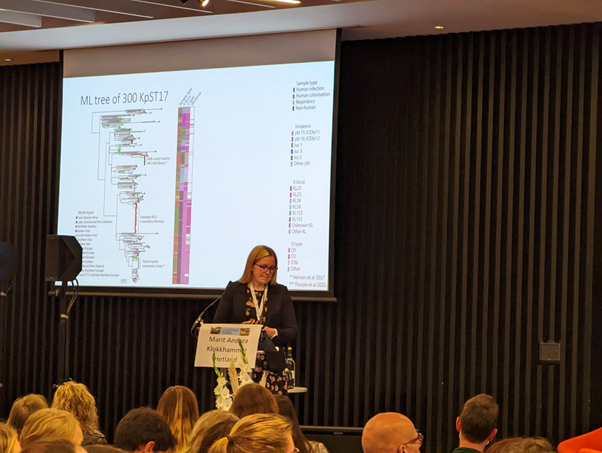Bugs in Bath: The 13th International Meeting on Microbial Epidemiological Markers (IMMEM XIII)
17 October 2022 London School of Hygiene & Tropical Medicine London School of Hygiene & Tropical Medicine https://lshtm.ac.uk/themes/custom/lshtm/images/lshtm-logo-black.png
With generous support from our LSHTM AMR Centre conference attendance grant, we attended the 13th International Meeting on Microbial Epidemiological Markers (IMMEM XIII) conference held in Bath (UK) 14-17 September 2022.
IMMEM was a wonderful opportunity to hear the latest advancements in genomics for epidemiological and AMR surveillance, with sessions on:
● Platforms for genome-based typing and epidemiology
● Incorporating new data types for real-time, genome-based surveillance
● Genome-based nomenclature
● Zoonosis, intensive food production and One Health
● Genomic epidemiology of neglected pathogens
● Genomic sequencing in LMIC
● The promise of long read sequencing
● Plasmid biology 2.0
● Metagenomics and Public Health
The conference is held every 3 years, and organised by the European Society of Clinical Microbiology and Infectious Diseases (ESCMID) Study Group on Epidemiological Markers (@ESGEM_ESCMID).
In close proximity to the past grandeur and purportedly healing waters of the Roman Baths, conference delegates immersed themselves in the triumphs and challenges of microbial genomic epidemiology and AMR surveillance. A lively debate started by asking “One Health or Public Health in the case of AMR?”. Evidence presented on both sides demonstrated that there is dissemination and mixing of AMR determinants from agriculture, water, and sewage, however, the problem of multidrug-resistant hospital pathogens that cause human morbidity and mortality was argued to be not related directly to this, and that interventions should focus on the infection prevention control sphere instead of One Health - the jury remains out.
A challenge highlighted throughout the meeting was the need for improved metadata standards and data integration, perhaps best summarised by Bill Hanage‘s (Harvard University) keynote presentation as the need for “genomes plus” other source data to contextualise and maximise the public health utility of sequenced isolates for AMR surveillance. AMR is a key driver for the development of genomic surveillance platforms, highlighted by Iruke Okeke’s keynote. Iruka explained that Nigeria’s national surveillance system was established despite huge technical challenges due to both limited infrastructure and procurement issues that hamper advances, a problem shared across many low- and middle- income countries.
Other highlights included Patrick Munk’s (Technical University of Denmark) findings from a multi-site metagenomic AMR surveillance study of domestic wastewater across 101 countries. Professor Martin Antonio (MRC Unit The Gambia at LSHTM) presented an overview of pathogen-based AMR surveillance work in West Africa to facilitate epidemic preparedness and response. Our LSHTM AMR Centre was represented by Francesc Coll and collaborators’ tour de force effort to improve AMR prediction for Enterococcus faecium from 4,370 whole genome sequences. Their findings are currently being integrated into the Pathogenwatch genomic epidemiology data analysis platform.
Many other resources for AMR surveillance and genetic epidemiology demonstrated included the Microreact data visualisation platform for aligning AMR data with phylogenies (Silvia Argimon, University of Oxford), the Enterobase database and analysis platform (Nabil-Fareed Alikhan, Quadrum Institute), PopPUNK clustering software (John Lees, EMBL-EBI), and the BIGSdb analysis platform (Keith Jolley, University of Oxford). For those looking for a dataset to further explore, or to test a tool or hypothesis, Grace Blackwell (EMBL-EBI, Wellcome Sanger Institute, & New South Wales Health, Australia) shared her beautifully curated collection of >661k searchable, consistently assembled, high quality, characterised bacterial genomes with rich metadata (more information available here, and example usage in AMR studies here).
Finally, the best oral presentation prize was awarded to Marit Hetland (Stavanger University Hospital & University of Bergen), for her work on within-patient evolution and global dynamics of drug-resistant Klebsiella pneumoniae ST17. Marit is currently visiting us at LSHTM, so please contact her to hear more about her award-winning work.
After a thoroughly stimulating first IMMEM experience, we find ourselves eagerly looking forward to the next one! If the closing ceremony vote was binding, and we do hope it was, either Porto (Portugal) or Tromsø (Norway) appeared to be likely hosts for the next meeting… perhaps we’ll see you there!
LSHTM's short courses provide opportunities to study specialised topics across a broad range of public and global health fields. From AMR to vaccines, travel medicine to clinical trials, and modelling to malaria, refresh your skills and join one of our short courses today.
